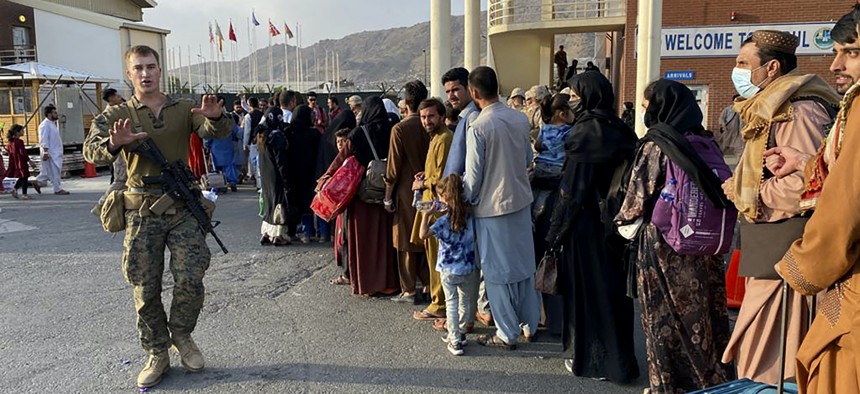TARA COPP and JACQUELINE FELDSCHER

“I think it is just a fundamental fact of the reality of where we are, that communications, and a certain measure of agreement with the Taliban, on what we're trying to accomplish has to continue to occur,” Pentagon press secretary John Kirby said.
About 7,000 people—a mix of Americans, Afghans and other foreign nationals—have left Kabul on U.S. military aircraft since non-combatant evacuation operations began last week, said Army Maj. Gen. William Taylor, deputy director of the Joint Chiefs of Staff.
The U.S. military has flown 12,000 people out of Afghanistan since July, Taylor said.
At a State Department press conference Thursday, spokesman Ned Price acknowledged that processing has been slow, but was improving.
“There are 6,000 people at the airport right now who have been fully processed by our consular team and will soon board planes,” Price said.
Twenty flights were expected to depart overnight Thursday, and State will double the number of consular officers on the ground by Friday, he said.
“We will have the capacity that we need to process as many individuals as we can to fill the flights,” Price said.
The evacuation has hit more of a “rhythm” in the last 24 hours, he said. For example, U.S. troops have opened and manned more gates at the airport, allowing faster processing of evacuees.
And satellite imagery examined by the Center for Strategic and International Studies shows that the crowds that swarmed the airport’s tarmac in recent days have disappeared, indicating that some order has been restored to airfield operations.
But currently, there are still more airplane seats than there are passengers. The U.S. would like to move between 5,000 and 9,000 people per day; over the last 24 hours, they flew out about 2,000, Taylor said Thursday morning.
Still to go are as many as 15,000 Americans and upwards of 70,000 Afghans: people who worked with the U.S. government and their families. But it’s not clear how many of the latter will be able to get to the airport; many live outside Kabul or in neighborhoods already locked down by the Taliban. Even the U.S. citizens may hesitate to move from their homes; the U.S. government said Wednesday that it cannot guarantee their safe passage.
“Every report of someone unable for whatever reason to reach the airport is something we take very seriously,” Price said. “We are doing everything we can mechanically, logistically, but then of course there’s also the diplomatic element to this as well. We are making very clear...together with our international partners...that safe passage should be guaranteed for all of those who wish to transit to the airport.”
On Wednesday on ABC News, President Joe Biden said U.S. troops may stay past the Aug. 31 deadline he set for their complete withdrawal if there are still Americans left behind -- but that presence now would have to be negotiated with the Taliban, Kirby said.
“If and when there's a decision to change that [deadline], then obviously that would require additional conversations with the Taliban,” Kirby said.
It’s not the airlift that’s the problem. Afghans who worked with the U.S. are having difficulty getting through Taliban-controlled checkpoints and if they do reach the airport, there’s additional processing delays at the gates.
“Just because you have 5,000 seats [doesn’t mean] that you can automatically fill 5,000 seats every day,” Kirby said.
Price was also asked about any COVID-19 mitigation measures that officials were taking on the planes, where pictures have shown hundreds of people packed together to evacuate. He said that in some countries where flights land, people who fled Afghanistan will be tested per local regulations, but “we don’t have the capacity to test everyone at the airport before they board.”
Dozens of C-17s have been landing at Kabul with troops, equipment, medical supplies, food, and water to provide care and shelter for those who get through the Taliban checkpoints and make it inside the airport, Taylor said.
While the Taliban control all areas outside of the airport, the inside is controlled by Marines and thousands of soldiers from the 82nd Airborne Division. As of Thursday, a total of 5,200 troops were based at the airport.
On Thursday, the Pentagon also acknowledged that armed F/A-18s from the Ronald Reagan carrier strike group are flying overwatch missions above the airport.
“The ability to provide close air support is something that needs to be immediate if a condition on the ground ever required that,” Taylor said.
No comments:
Post a Comment